Reactive Gases Research
What are reactive gases?
The reactive gases as a group are very diverse and include surface ozone (O3), carbon monoxide (CO), volatile organic compounds (VOCs), oxidised nitrogen compounds (NOx, NOy), and sulphur dioxide (SO2). All of these compounds play a major role in the chemistry of the atmosphere and as such are heavily involved in inter-relations between atmospheric chemistry and climate, either through control of ozone and the oxidising capacity of the atmosphere, or through the formation of aerosols. The global measurement base for most of them is entirely unsatisfactory, the only exceptions being surface ozone and carbon monoxide.
Scientific Advisory Group for Reactive Gases advises on implementation of the GAW Programme for this group of gases.
Recommendations on the measurements and their quality assurance are given in respective Measurement Guidelines.
Data on reactive gases can be found at the WMO/GAW World Data Centre for Greenhouse Gases (WDCGG).
GAW observations of reactive gases collected in near-real time are used for model validation in the MACC project.
The first Reactive Gas Bulletin has been published in April 2017.
Surface ozone
Surface ozone observations in GAW (movie)
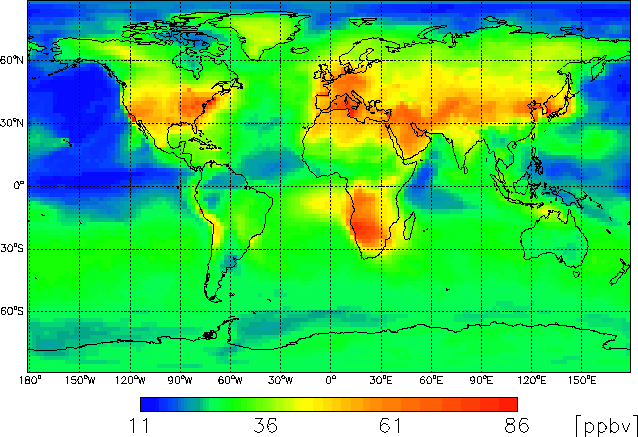 |
| Monthly mean afternoon (1 to 4 PM) surface ozone concentrations calculated for July using Harvard GEOS-CHEM model. |
Ozone (chemical formula O3) in the troposphere (i.e. the lowermost part of the atmosphere, from the surface to 6-15 km height depending on the latitude) is highly relevant for the Earth’s climate, ecosystems, and human health. Tropospheric ozone is the third largest contributor to greenhouse radiative forcing after carbon dioxide and methane. It is part of the Earth’s shield against ultraviolet radiation, particularly when there is stratospheric ozone depletion. Ozone plays a crucial role in tropospheric chemistry as the main precursor for the OH radical which determines the oxidation capacity of the troposphere, it is a toxic air pollutant affecting human health and agriculture, and, through plant damage, it impedes the uptake of carbon into the biosphere. Accurate long-term measurements of ozone in the troposphere, including near the earth surface in unpolluted and polluted environments, are needed in order to assess the impacts of tropospheric ozone on the earth system, human health and ecosystems, and to detect changes in the atmospheric composition which could aggravate or reduce these impacts because of changing ozone precursor emissions or climate change.
Our knowledge of trends in the global distribution of surface ozone is still incomplete and observed trends have varied both temporally and spatially. The Global GAW stations are distributed relatively evenly, but overall, most surface ozone monitoring stations are still located in northern mid-latitudes. There is a need for more remote stations measuring ozone in the middle of continents (e.g., continental Asia), in the tropics and in the southern hemisphere.
Regular performance audits at many of the Global GAW stations show that these stations are providing measurements of the required quality. The existing Data Quality Objectives are met by almost all stations.
Carbon monoxide
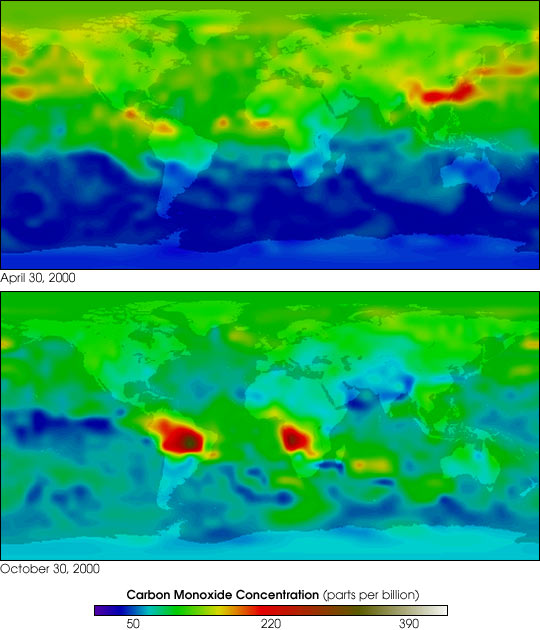 |
| The MOPITT sensor aboard NASA’s Terra satellite measures carbon monoxide in the Earth's atmosphere. The false colors represent levels of carbon monoxide in the lower atmosphere, ranging from about 390 parts per billion (dark brown pixels), to 220 parts per billion (red pixels), to 50 parts per billion (blue pixels). |
Carbon monoxide (CO) is present only in trace quantities in the atmosphere but plays an important role in atmospheric chemistry. CO is part of a photo-chemically driven reaction sequence that links methane (CH4), formaldehyde, ozone (O3) and the hydroxyl radical (OH). In much of the background troposphere the reaction of CO and OH accounts for all of the chemical loss of CO and about 75% of the removal of OH. Reaction with OH is the primary removal pathway for some greenhouse gases such as CH4, therefore trends in atmospheric CO levels are expected to have an indirect effect on climate through their role in regulating OH. CO also plays an important role as a precursor of tropospheric ozone, an air pollutant and greenhouse gas. CO has a relatively long atmospheric lifetime, ranging from 10 days in summer in the tropics to more than a year over polar regions in winter.
Greatest CO mole fractions in the background troposphere at the surface are found in the high latitudes of the Northern Hemisphere (NH) and lowest CO occurs in the high latitudes of the Southern Hemisphere (SH). The annually averaged latitudinal gradient reflects the predominance of anthropogenic emissions in the Northern Hemisphere (Figure 1). CO exhibits a seasonal cycle driven by an imbalance of its source and sinks. In both hemispheres, reaction with OH leads to a minimum in summer. The NH winter maximum results largely from a build-up of anthropogenic emissions, while in the SH, biomass burning leads to a maximum in spring. The largest difference between the high northern and high southern hemispheres (~150 nmol mol-1) occurs in February/March and the minimum (~10 nmol mol-1) in September/October.
Volatile organic compounds (VOCs)
Measurement of VOCs is complex due to the many different molecules present in the atmosphere. The measurement of many of these species is important for air quality purposes, however, only a few molecules can be measured routinely in the background atmosphere. The WMO/GAW Experts Workshop on Volatile Organic Compounds (VOCs) was held in Geneva, Switzerland, from 30 January to 1 February 2006, to discuss the needs of a manageable VOC measurement programme for GAW (GAW Report 171). A core set of molecules was identified, taking into account their ease of measurement in a flask network, and their usefulness in providing information on many processes such as emissions from defined sources, long-range transport, and chemical loss processes (see table below). In addition, a basic flask network was identified making use of existing networks used to provide greenhouse gas measurements for GAW via NOAA (NOAA and INSTAAR Global VOCs network), and for regional VOC measurements in Europe via EMEP. The core species measured in this network, with a frequency of the order of one per week would be supplemented by more frequent measurements of a wider range of species at a small number of well-maintained sites in Europe and North America, and on mid Atlantic islands. The GAW data base on VOCs will include measurements made from aircraft, both research aircraft and in-service aircraft operating in the CARIBIC project. Also measurements of formaldehyde (CH2O) and glyoxal (1,2-ethanedione, HCOOCH) will be made at specific sites for the ground truthing of data produced by satellites. The GAW Workshop proposed the following molecules, as shown in the Table below:
| Compound | Lifetime | Purpose |
|---|---|---|
| Ethane | 2-4 months |
Mixed, mainly anthropogenic, sources; tracer for methane sources; trends in global OH; impact of Cl atom chemistry
|
| Propane | 3 weeks |
Mixed, mainly anthropogenic, sources; tracer for methane; trends in global OH
|
| Acetylene | 3 weeks |
Tracer for vehicular emissions and biomass burning; air mass age
|
| Isoprene | 1-2 hours |
Biogenic emissions; source of formaldehyde; ozone precursor; emissions sensitive to environmental conditions/climate
|
| Terpenes | 1 hour |
Aerosol precursor
|
| DMS | 1 day |
Aerosol precursor; tracer for marine emissions/productivity
|
| Formaldehyde | 2 hours – 2 days |
Indicator of isoprene oxidation; satellite validation
|
| Acetonitrile | 0.4 – 1 year |
Biomass burning tracer
|
| Methanol | 2 weeks |
Oxidation product; biogenic emissions
|
| Ethanol | 1 week |
Oxidation product; biofuel tracer
|
| Acetone | 1 month |
Oxidation product; source of free radicals
|
| Benzene | 1 week |
Tracer for combustion processes
|
| Toluene | 2 days |
Aerosol precursor
|
| Iso-/n-Butane | 2-3 days |
Air mass age/OH concentration
|
| Iso-/n-Pentane | 2-3 days |
Impact of NO3 chemistry
|
Nitrogen oxides (NOx)
 |
| Based on 18 months of Envisat observations, this high-resolution global atmospheric map of nitrogen dioxide pollution makes clear just how human activities impact air quality. Data are from the Scanning Imaging Absorption Spectrometer for Atmospheric Chartography (SCIAMACHY) instrument on Envisat. From European Space Agency |
The sum of nitric oxide (NO) and nitrogen dioxide (NO2) has traditionally been called NOx. Likewise the sum of many oxidised nitrogen species, both organic and inorganic but excluding nitrous oxide (N2O) and ammonia (NH3), acetonitrile (CH3CN) and hydrocyanic acid (HCN) have traditionally been referred to as NOy. Their measurement in the global atmosphere is very important since NO has a large influence on both ozone and on the hydroxyl radical (OH). NO2 is now being measured globally from satellites and these measurements suggest that substantial concentrations of this gas are present over most of the continents. A large reservoir of fixed nitrogen is present in the atmosphere as NOy. The influence of the deposition of this reservoir on the biosphere is not known at present but could be substantial. There are efficient in-situ measurement techniques for NO and NOy, and to a lesser extent NO2. A large amount of data on these species has been collected in the past in association with the control of regional pollution. The global data base is more limited and consists mostly of aircraft measurements collected over the world oceans.
Sulphur dioxide (SO2)
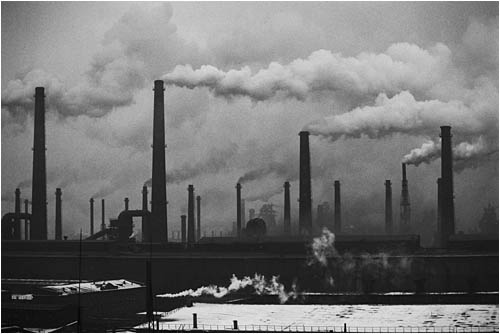 |
| Emissions from industry and power generation based on fossil fuel contain sulphur dioxide |
Sulphur dioxide (SO2) is the main precursor to the sulphate aerosol which exerts a large influence on world climate. It is a regulatory pollutant controlled in many countries for human health effects by monitoring networks that may or may not be operated by NHMSs. Many measurements have been made in association with its role as a regional pollutant, particularly its role as a precursor to acid rain. Many measurements are available from integrating techniques such as filter observations used by regional networks such as EMEP, CAPMoN and NADP. However, there are very few measurements in the background atmosphere. This is a very unsatisfactory situation that has a number of causes, in particular the lack of a suitable instrument for regular measurement at the low concentrations found there. It is important to remedy this in order to create a database suitable for the proper validation of models used to predict global sulphate aerosol distribution, and its present and future influence on climate.
Sulphur dioxide concentrations in many areas in the developed world have been declining due to restrictions on emissions. It is possible that they may increase in some areas with currently expanding economies such as South and South-East Asia. The impact of these emissions and indeed emissions from all regions on the global sulphate aerosol distribution needs to be quantified urgently through an organized measurement programme.
Volcanos and SO2
Volcanic eruptions can lower mean global temperatures. It was thought for many years that the greatest volcanic contribution of the haze effect was from the suspended ash particles in the upper atmosphere that would block out solar radiation. However, these ideas changed in the 1982 after the eruption of the Mexican volcano, El Chichon. Although the 1980 eruption of Mt. St. Helens lowered global temperatures by 0.1C, the much smaller eruption of El Chichon lowered global temperatures three to five times as much. Although the Mt. St. Helens blast emitted a greater amount of ash in the stratosphere, the El Chichon eruption emitted a much greater volume of sulfur-rich gases (40x more). It appears that the volume of pyroclastic debris emitted during a blast is not the best criteria to measure its effects on the atmosphere. The amount of sulfur-rich gases appears to be more important. Sulfur combines with water vapor in the stratosphere to form dense clouds of tiny sulfuric acid droplets. These droplets take several years to settle out and they are capable to decreasing the troposphere temperatures because they absorb solar radiation and scatter it back to space.
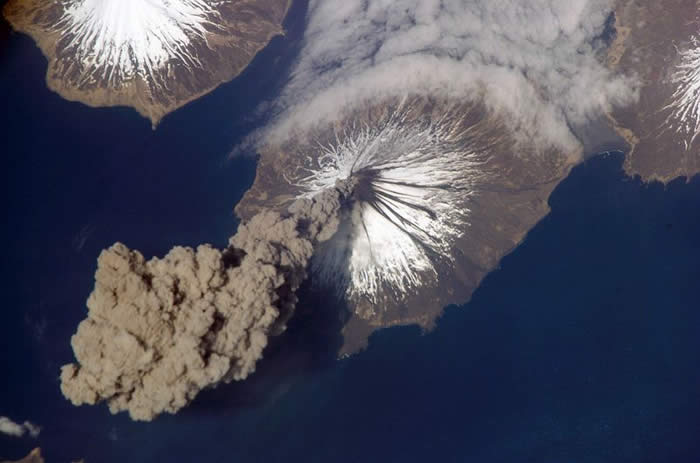 |
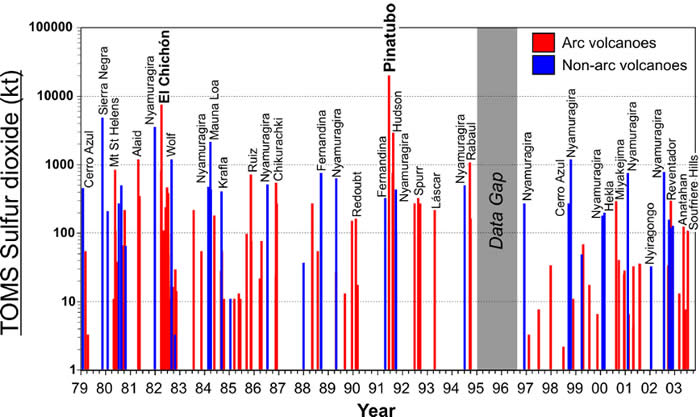 |
Recent chart of TOMS volcanic SO2 against time |
Scientific Advisory Group
Science Advisory Group members
SAG Meetings:
- Daejeon, South Korea, 22-24 October 2014 (materials are here)
- Garmisch-Patenkirchen, Germany, 13-15 November 2013 (meeting presentations and report)
- Gozo, Malta, 29-30 March 2011 (materials are here)
Measurement Guidelines
Reports and Publications Related to Reactive Gases
- Elementa special feature https://collections.elementascience.org/reactive-gases-in-the-global-atmosphere/
- review paper "Global distribution and trends of tropospheric ozone: An observation-based review" that utilizes GAW observations was published in Elementa.
Useful links
- Air quality levels in Europe (by European Environment Agency)
- The European Monitoring and Evaluation Programme (EMEP)
- Acid Deposition Monitoring Network in East Asia (EANET)
- ACTRIS (Aerosols, Clouds, and Trace gases Research InfraStructure Network)
- Air Pollution in China: Real-time Air Quality Index Visual Map
- Air Now
- MACC (Monitoring Atmospheric Composition and Climate) project
- IGAC/SPARC Chemistry-Climate Model Initiative (CCMI) working group on improved evaluation of chemistry-climate models using in-situ research aircraft data
- In-service Aircraft for a Global Observing System (IAGOS) project
- Task Force on Hemispheric Transport of Air Pollution (TF HTAP)
